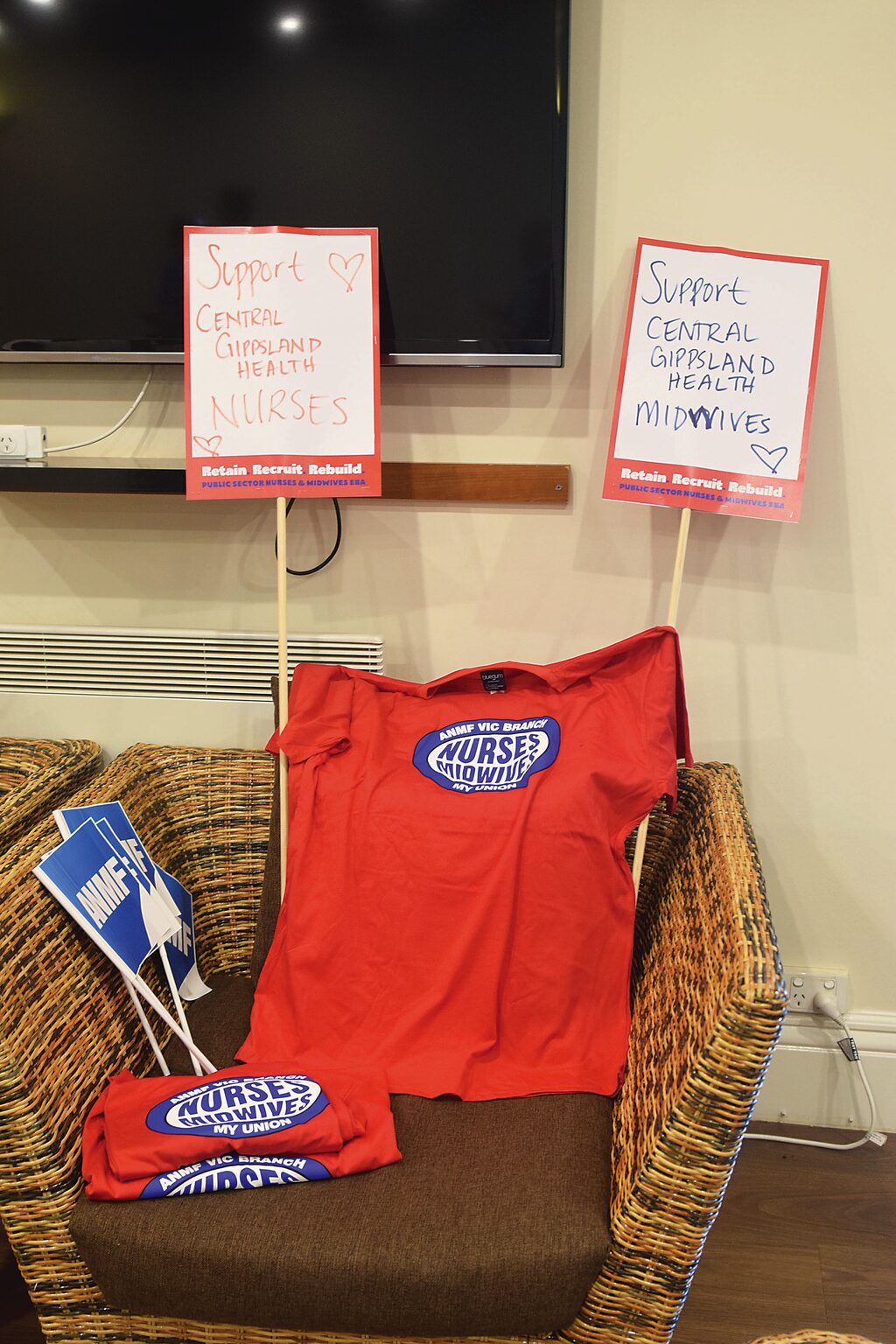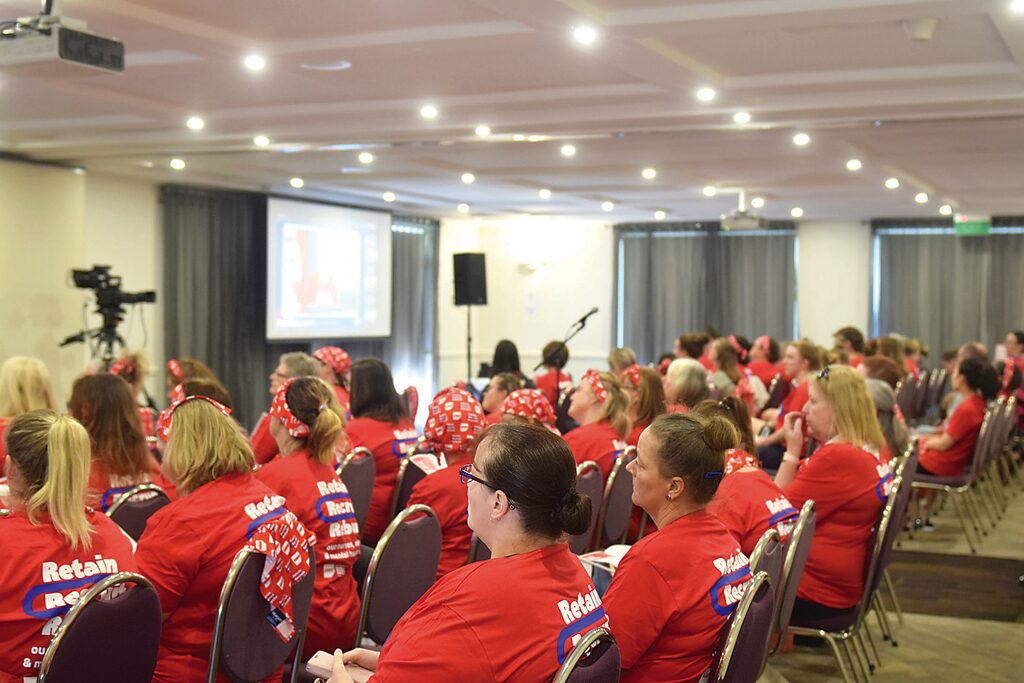By ZAIDA GLIBANOVIC
PUBLIC sector nurses in Victoria have taken a step toward protected industrial action following a vote on Thursday, March 21.
On behalf of 60,000 Victorian nurses and midwives, the Australian Nursing and Midwifery Federation (Victorian Branch) (ANMF) is negotiating a new enterprise agreement for the 2024-28 period.
The union says it does not take industrial action lightly and will only use walk-outs as a last resort option. In 2012, 30 nurses walked off the job at Latrobe Regional Hospital campaigning for better wages and fixed nurse-patient ratios. In that time, up to 15 surgical procedures were forced to be cancelled due to the stoppages.
At this stage, it is unclear how much of Latrobe Regional Hospital is unionised and how an approved industrial action would affect the hospital.
On Thursday, the ANMF (Victorian Branch) held a statewide meeting to speak on a progress report on their EBA.
A sea of red T-shirts with union slogans overran Traralgon’s Century Inn, as there were about 70 members who attended the regional streaming site to watch the meeting based at the Carson Conference Centre.

The union has rejected the state government’s offer of an annual three per cent wage increase over four years and an additional one-off $1500 payment for full-time employees.
The ANMF Victorian branch secretary, Lisa Fitzpatrick, said they had reached a crisis point in negotiations that started in October last year.
“The Allan government’s one-size-does-not-fit-all wages policy will fail the Victorian health system and fail the Victorian community because it will fail to reverse the expensive and increasing casualisation of Victoria’s nursing and midwifery workforce,” she said.
Members supported ANMF and the Victorian government’s progress on non-cost EBA items but directed their union to continue negotiations given the total lack of progress on any cost claims that are designed to address the systemic and increasing casualisation of the workforce.
The union’s members have expressed their growing concern over increased casualisation in the industry due to rostering issues.
“Today, work intensification and unpopular employer rostering practices such as redeployment and constant management requests to work additional shifts and overtime mean nurses and midwives are moving from permanent to casual so they can control their hours,” Ms Fitzpatrick said.

The ANMF secretary compared the dire situation of the industry to the late 1990s when the Jeff Kennett Government funding cuts depleted the public health system.
“We worked above and beyond for the Victorian community through the 2020 summer bushfires, the once-in-a-100-year COVID-19 pandemic, multiple flood events and the most significant staffing pressures since the 1990s nursing and midwifery crisis,” a union report stated.
The 2020-24 agreement expires on April 30.
“Nurses and midwives are asking their employers to listen to them, to acknowledge what’s happened over the last five years of COVID and to implement cost-effective initiatives that will retain and recruit early career and experienced staff and rebuild the permanent workforce,” Ms Fitzpatrick said.
ANMF members are seeking a range of claims designed to retain, recruit and rebuild our early career and experienced nurses and midwives.
According to the ANMF, about 30 per cent of a nurse or midwife’s take-home pay comprises allowances above the base rate. ANMF is claiming about 15 new or improved financial incentives to reward working additional permanent hours and unpopular shifts, and to retain a permanent workforce.
ANMF is also seeking the introduction of financial disincentives for unpopular employer rostering practices such as redeployment, excessive reliance on overtime and missed meal breaks. Many of the claims, developed and endorsed by ANMF workplace delegates, would only flow to permanent staff.
Nursing and Midwifery Board of Australia registration figures show net growth of more than 16,000 Victorian nurses and midwives over the last five years. While the workforce has increased, filling rosters remains challenging because nurses and midwives are reducing their hours and moving from permanent to casual employment.

ANMF will make an application for a protected industrial action ballot in the Fair Work Commission in the coming days.
“Nurses and midwives only ever take industrial action as a last resort to protect the professions, the health system and patient care,” Ms Fitzpatrick said.
“The stakes are high, and they know the outcome of this EBA must stop casualisation and deliver a permanent and sustainable workforce.”
Negotiations between the parties will continue next week, with a state government spokesperson telling the Canberra Times that they were committed to negotiating in good faith.
The ANMF aren’t the only public service union negotiating new EBAs, with the Victorian Paramedics beginning action on Monday, March 18, V/Line staging stoppages at least once every month since December last year and the Police Association initiating action in late last year.











